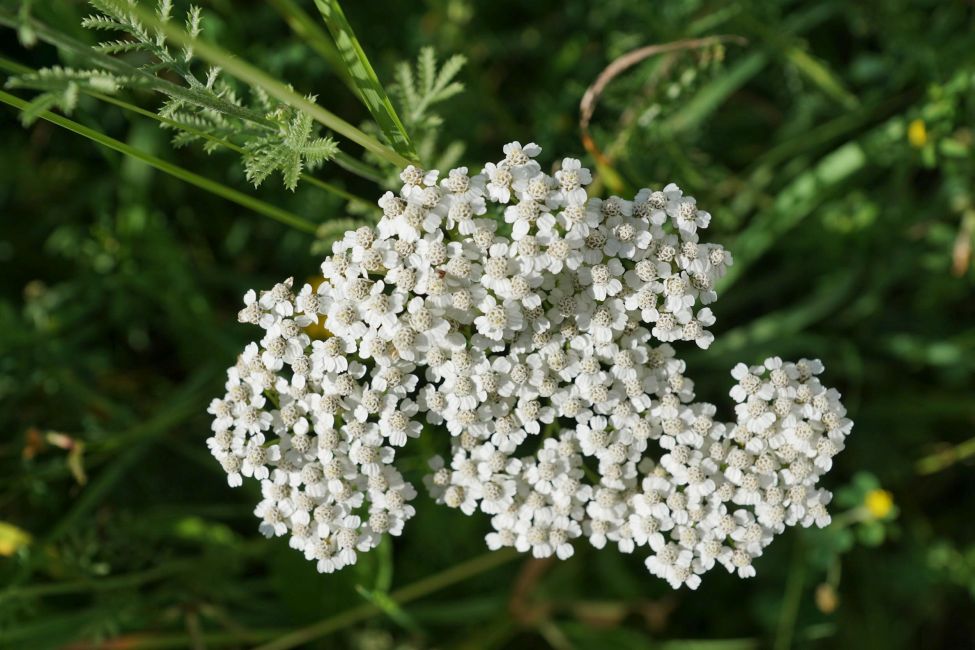by Quinn K Dyer
Know it:
This plant is known by many names: yarrow, nosebleed plant, milfoil, soldier’s woundwort, bloodwort, staunchweed, soldier’s herb, etc. (And those are just the English names!)
The healing properties of yarrow, or Achillea millefolium, have been known to mankind since antiquity.
The Latin name stems from Achilles, the Greek hero, who used the plant to treat battle wounds at Troy.
Many Native American tribes used the plant medicinally too. They used the plant to treat everything from toothaches to fevers to digestive issues to burns.
Even cooler, there’s evidence that Neanderthals used yarrow. That means the plant has been in use for over 60,000 years.
Magickally, the plant offers powerful grounding and protective energy.
Patches of yarrow, especially when found in the wild, indicate a spot of grounded energy. They make excellent places to meditate. The plant can also be used in spells for divination, courage, focus, and love.

Grow it:
Yarrow tolerates most growing conditions, but prefers to be dry. In fact, it is very hardy and drought resistant.
It’s a very low maintenance plant that makes an easy addition to any magickal or medicinal garden.
To increase oil content in the plant grow/create stressful conditions, such as drought. This gives the plant a higher oil content and therefore more potency when using medicinally.
Yarrow makes an excellent companion plant. It is not only great at attracting bees and other helpful bugs.
But the root secretions actually boost the immune systems of the plants around it, helping to ward off disease.
It can often be found growing in the wild. In fact, the wild, white-flowered variety is one of the better medicinal varieties.
The blooms can range from white to yellow to pink or red.
The leaves are quite distinct and ferny and I’ve found it to be one of the easier plants to be sure of when wildcrafting.
Species of yarrow are native to Europe, Asia, and North America.
When flowers begin to fade cut or pluck them off to encourage more flower growth. It will bloom all season long.
Leaving the flowers will encourage it to reseed, so if you want to control its growth, pluck away!
I’ve had bad luck getting yarrow seeds to germinate, but it easily grows from root cuttings. It does tend to grow in clumps.
Yarrow can be an aggressive grower, so it may be best to grow in pots.
However it doesn’t need high-quality soil and doesn’t always thrive in it, so if starting in a container mix potting soil with lower quality dirt.
There is an allergy risk with yarrow. Rashes can develop from the plant coming in contact with wet skin.
If you develop a rash while harvesting; do not ingest. Don’t be discouraged from gardening if allergies to a plant prevent you from using it.
Try another! Even the greenest witches aren’t in tune with every plant.
This plant is also toxic to dogs, cats and other animals. Be careful when planting, so you don’t harm your furry friends!

Use it:
Yarrow is traditionally harvested Midsummer’s day for magickal use, but the plant can be harvested all season long.
Whole aerial parts should be harvested while flowering. Used fresh or dried.
Dried flower heads can be used in divination and love spells. Combine mugwort and yarrow for a potent aid to divination, either as a tea or incense.
Yarrow is frequently used to treat fevers at home. Tea can be drunk or added to a bath to help relieve a cold or fever.
This has the added benefit of inducing a calm sleep.
It staunches bleeding, stimulates the blood, cleanses wounds, and promotes healing. A bandage soaked in cold tea will staunch the bleeding; mashed leaves also work for this purpose.
Chilled tea can also be used to wash sunburns to help them heal and relieve pain.
For bad menstrual cramps or to sweat a fever, boil a pot of water and add fresh yarrow (or essential oils if none are available) along with a few drops of coconut oil.
Let steep for 5-10 minutes and pour in a tub filled with hot water. Soak for at least 20 minutes to absorb all the goodness (No more than 3x a week).
For an extra potent soak combine the herbs with a cup of Epsom salts. Be wary when buying Epsom salts because they often have unnecessary added chemical fragrances and dyes.
IN CONCLUSION
If this essay resonates with you, please join our WITCH email list by using the forms on this website so we can stay in touch.
About the Author:
 Quinn K. Dyer is a native of Philadelphia, born under Gemini, a witch and a wanderer. She currently spends her time writing and creating art. Check out her website and Instagram.
Quinn K. Dyer is a native of Philadelphia, born under Gemini, a witch and a wanderer. She currently spends her time writing and creating art. Check out her website and Instagram.
all images from Canva







